The Atlanta BeltLine, a transformative urban renewal project, has emerged as a beacon of progress in the heart of Atlanta. This comprehensive guide delves into the rich history, multifaceted impact, and exciting future plans of this remarkable initiative.
Spanning over 22 miles, the Atlanta BeltLine is a multi-use trail system that encircles the city’s core. It has revitalized neighborhoods, fostered a vibrant arts and culture scene, and created countless opportunities for recreation and transportation.
Atlanta BeltLine History
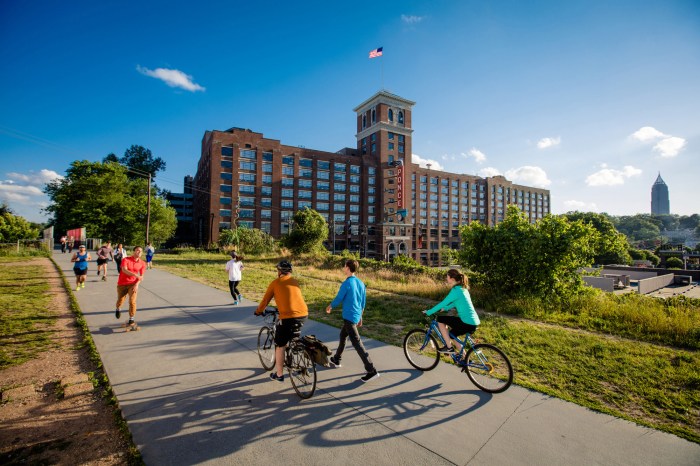
The Atlanta BeltLine is a transformative 22-mile loop of multi-use trails, parks, and transit connecting 45 intown neighborhoods. The project’s origins can be traced back to the 1990s when a group of citizens, led by Ryan Gravel, proposed converting the city’s abandoned rail corridor into a linear park.
Timeline
- 1999: The Atlanta BeltLine Partnership is formed as a non-profit organization to lead the project’s development.
- 2005: The City of Atlanta adopts the BeltLine Master Plan, which Artikels the project’s vision and goals.
- 2008: Construction begins on the first phase of the BeltLine, the Eastside Trail.
- 2012: The Westside Trail opens to the public.
- 2014: The Atlanta BeltLine is designated as a National Recreation Trail by the National Park Service.
- 2016: The Atlanta BeltLine is awarded the Urban Land Institute’s Global Award for Excellence.
- 2020: The BeltLine is completed with the opening of the final segment, the Southside Trail.
Challenges and Milestones
The Atlanta BeltLine project has faced numerous challenges over the years, including funding shortfalls, environmental concerns, and opposition from some residents. However, the project has also achieved significant milestones, including the construction of over 20 miles of trails, the creation of new parks and green spaces, and the stimulation of economic development in intown Atlanta.
Atlanta BeltLine Segments
The Atlanta BeltLine is a transformative project that has been revitalizing Atlanta’s neighborhoods and connecting the city through a network of trails, parks, and greenspace.
The BeltLine is divided into several segments, each with its unique characteristics and attractions. These segments are connected to surrounding neighborhoods, providing residents and visitors with access to green space, recreation, and transportation options.
The Atlanta BeltLine, a sustainable urban renewal project, is a great example of how cities can create vibrant and livable spaces while promoting environmental stewardship. For those seeking sustainable travel destinations, the BeltLine offers a unique blend of greenways, parks, and mixed-use development, making it an ideal place to explore sustainable travel destinations.
Whether you’re a cyclist, walker, or simply looking for a peaceful oasis in the heart of the city, the Atlanta BeltLine is a must-visit destination for eco-conscious travelers.
Segment Overview
| Segment | Length | Key Features |
|---|---|---|
| Eastside Trail | 3.1 miles | Historic Fourth Ward Skatepark, Historic Old Fourth Ward Park, Atlanta BeltLine Arboretum |
| Westside Trail | 3.3 miles | Historic Westside Reservoir Park, Westside Park at Bellwood Quarry, Westside Provisions District |
| Southside Trail | 2.2 miles | Historic Oakland Cemetery, Grant Park, Zoo Atlanta |
| Northside Trail | 2.5 miles | Historic Inman Park, Piedmont Park, Atlanta Botanical Garden |
The Eastside Trail is known for its vibrant arts and culture scene, with numerous galleries, studios, and public art installations. The Westside Trail offers a more industrial vibe, with historic warehouses and factories being converted into trendy shops and restaurants. The Southside Trail is home to some of Atlanta’s most iconic landmarks, including Oakland Cemetery and Zoo Atlanta. The Northside Trail winds through some of the city’s most affluent neighborhoods, providing access to parks, gardens, and the Atlanta Botanical Garden.
All of the BeltLine segments are connected to surrounding neighborhoods via a network of trails, sidewalks, and bike lanes. This makes it easy for residents and visitors to access the BeltLine and enjoy its many amenities.
Atlanta BeltLine Impact
The Atlanta BeltLine has had a significant impact on the city, both economically and socially. The project has created jobs, boosted property values, and revitalized neighborhoods. It has also improved the city’s air and water quality and provided new opportunities for recreation and exercise.
Economic Impact
The Atlanta BeltLine has created an estimated 30,000 jobs and generated $5 billion in economic activity. The project has also boosted property values along the BeltLine corridor. A study by Georgia State University found that property values within a half-mile of the BeltLine have increased by an average of 10% since the project began.
Social and Environmental Benefits, Atlanta beltline
The Atlanta BeltLine has also had a positive impact on the city’s social and environmental health. The project has created new green spaces, improved air and water quality, and provided new opportunities for recreation and exercise. The BeltLine has also helped to connect different neighborhoods and communities.
Revitalization of Neighborhoods
The Atlanta BeltLine has helped to revitalize several neighborhoods along its corridor. The project has brought new businesses, residents, and investment to these areas. For example, the Old Fourth Ward neighborhood has seen a surge in new development since the BeltLine opened. The neighborhood is now home to several new restaurants, shops, and apartments.
Promotion of Sustainable Living
The Atlanta BeltLine is also helping to promote sustainable living in the city. The project encourages walking, biking, and public transportation. It also provides new opportunities for urban gardening and composting. The BeltLine is a model for sustainable development and is helping to make Atlanta a more livable city.
Atlanta BeltLine Future Plans
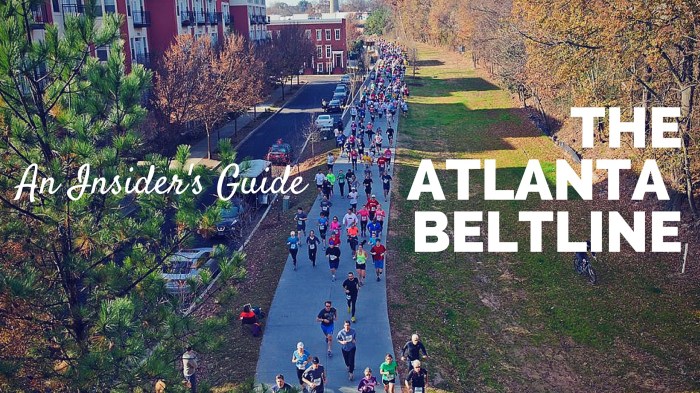
The Atlanta BeltLine is poised for significant expansion and development in the coming years. With ongoing and future plans in place, the BeltLine aims to extend its reach, enhance amenities, and forge new partnerships to shape Atlanta’s future.
Proposed Extensions
The BeltLine’s expansion plans include extending the Northeast Trail from Lindbergh Center to Lenox Road, connecting popular destinations and expanding access to the BeltLine network. Additionally, the Southside Trail is set to be extended from Glenwood Avenue to I-285, providing a vital link between the city’s southside communities and the BeltLine’s existing infrastructure.
New Amenities
Future plans for the BeltLine also encompass the development of new amenities to enhance the experience for users. These include the addition of parks, playgrounds, and green spaces, as well as bike repair stations and other facilities to support recreational activities. The BeltLine is also exploring the creation of mixed-use developments along its corridor, offering a blend of residential, commercial, and retail spaces.
Potential Partnerships
The Atlanta BeltLine is actively seeking partnerships with organizations and businesses to support its future development. These collaborations aim to leverage expertise and resources to enhance the BeltLine’s offerings, such as partnering with local arts organizations to curate public art installations or collaborating with transportation providers to improve connectivity. By fostering these partnerships, the BeltLine aims to create a truly integrated and vibrant public space.
Long-Term Vision
The Atlanta BeltLine’s long-term vision is to transform Atlanta into a more livable, sustainable, and equitable city. By providing accessible green space, promoting active transportation, and fostering economic development, the BeltLine aims to create a connected and thriving community. The BeltLine’s future plans are integral to realizing this vision, ensuring its enduring impact on Atlanta’s urban landscape and the well-being of its residents.
Atlanta BeltLine Art and Culture
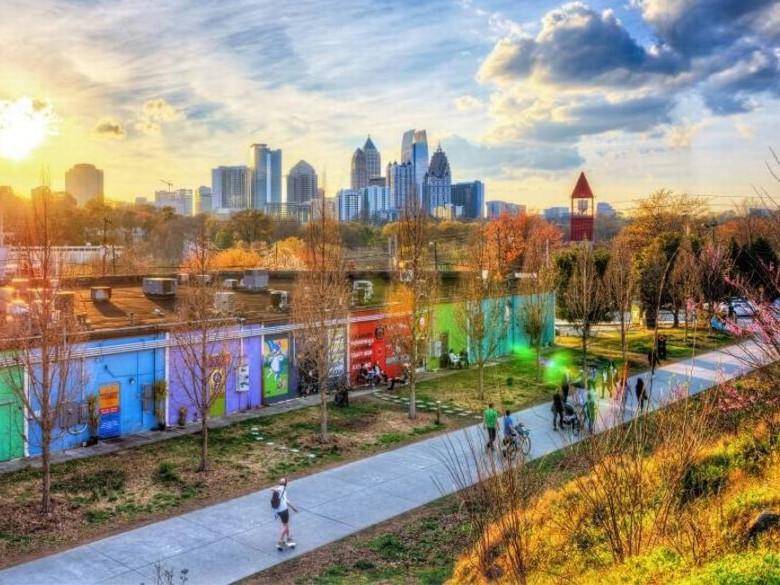
The Atlanta BeltLine is not only a transformative infrastructure project but also a vibrant hub for arts and culture. Along its 22-mile loop, the BeltLine showcases an array of public art installations and cultural attractions that celebrate Atlanta’s diverse heritage and foster a thriving arts scene.
Notable Public Art Installations and Cultural Attractions
The BeltLine features a diverse collection of public art installations, including sculptures, murals, and interactive pieces. These works represent a wide range of art forms, from traditional to contemporary, and reflect the city’s rich cultural tapestry.
| Art Installation | Artist | Location | Description |
|---|---|---|---|
| The Connector | Hank Willis Thomas | Reynoldstown | A monumental sculpture that symbolizes the BeltLine’s role in connecting Atlanta’s communities. |
| The Beacon | Adam Kuby | Old Fourth Ward | A towering kinetic sculpture that responds to wind and light, creating a dynamic and ever-changing artwork. |
| The Nest | Janet Echelman | Inman Park | A large-scale aerial sculpture that resembles a bird’s nest, providing a unique perspective of the BeltLine and the surrounding neighborhood. |
| The BeltLine Arboretum | Various Artists | Multiple Locations | A series of outdoor art installations that showcase the diverse plant life found along the BeltLine, celebrating Atlanta’s natural beauty. |
In addition to public art, the BeltLine is home to several cultural attractions, such as:
- The Atlanta BeltLine Arboretum, which features a collection of over 2,000 trees and plants.
- The Atlanta BeltLine Eastside Trail, which connects the Old Fourth Ward to the Inman Park neighborhood and features a variety of art installations and performance spaces.
- The Atlanta BeltLine Westside Trail, which connects the West End to the Bankhead neighborhood and offers scenic views of the city skyline.
Fostering a Vibrant Arts and Culture Scene
The Atlanta BeltLine has played a significant role in fostering a vibrant arts and culture scene in Atlanta. The public art installations and cultural attractions along the BeltLine provide opportunities for residents and visitors to engage with art in a unique and accessible way. The BeltLine also serves as a platform for local artists to showcase their work and connect with a wider audience.
The BeltLine’s commitment to arts and culture has helped to revitalize Atlanta’s neighborhoods, attract new businesses, and create a more vibrant and livable city. It has also strengthened Atlanta’s reputation as a cultural destination, attracting visitors from around the world to experience the city’s unique artistic offerings.
Atlanta BeltLine Recreation and Trails

The Atlanta BeltLine offers a diverse range of recreational opportunities, catering to various interests and fitness levels. Its interconnected trails provide a scenic and accessible outdoor escape for walkers, runners, cyclists, and other outdoor enthusiasts.
The BeltLine’s extensive trail system encompasses over 33 miles of paved and multi-use paths, seamlessly connecting intown neighborhoods with parks, green spaces, and cultural attractions. The trails are designed to accommodate a wide range of activities, from leisurely strolls to invigorating bike rides.
Accessibility and Amenities
The Atlanta BeltLine prioritizes accessibility and inclusivity, ensuring that all users can enjoy its recreational amenities. The trails are wheelchair accessible and feature wide paths, making them suitable for individuals with disabilities or families with strollers. Rest areas and water fountains are strategically placed along the trails for convenience and refreshment.
Cyclists are well-catered for, with dedicated bike lanes and bike-sharing stations located throughout the BeltLine. These facilities encourage sustainable transportation and promote a healthy and active lifestyle.
Promoting Healthy Lifestyles
The Atlanta BeltLine plays a pivotal role in promoting healthy lifestyles within the city. Its easily accessible trails provide a safe and enjoyable environment for individuals to engage in regular physical activity. Studies have shown that access to green spaces and recreational trails can significantly improve overall well-being, reduce stress levels, and encourage a more active lifestyle.
The Atlanta BeltLine is a planned 22-mile loop of multi-use trails, parks, and transit that will connect 45 intown neighborhoods. This ambitious project will create a more livable, sustainable, and equitable city. One of the most exciting aspects of the BeltLine is its potential to connect people to other parts of the region, such as albany.
The BeltLine will make it easier for people to get around without a car, and it will also provide new opportunities for recreation and exploration.
The BeltLine also fosters a sense of community and encourages social interaction. Its trails serve as a gathering place for neighbors, friends, and families to connect and enjoy the outdoors together. This social aspect contributes to a more vibrant and engaged community.
Community Engagement
Beyond its recreational benefits, the Atlanta BeltLine is a catalyst for community engagement and revitalization. The trails connect diverse neighborhoods, providing a shared space for residents to interact and foster a sense of belonging. Community gardens, public art installations, and educational programs along the BeltLine further enhance its role as a vibrant and inclusive public space.
The Atlanta BeltLine is a popular urban trail that encircles the city, offering a scenic path for walking, biking, and exploring. Along its 22-mile loop, the trail passes through diverse neighborhoods, parks, and green spaces. If you’re looking for a change of pace, consider exploring the best beaches in the Caribbean.
These tropical paradises offer crystal-clear waters, white-sand beaches, and a relaxing atmosphere. After your beach getaway, return to the Atlanta BeltLine to continue your urban adventure.
The Atlanta BeltLine is a testament to the power of urban planning and the transformative impact of creating accessible and engaging outdoor spaces. Its recreational trails not only provide a sanctuary for physical activity and mental well-being but also contribute to a more livable, healthy, and connected city.
Atlanta BeltLine Real Estate Development
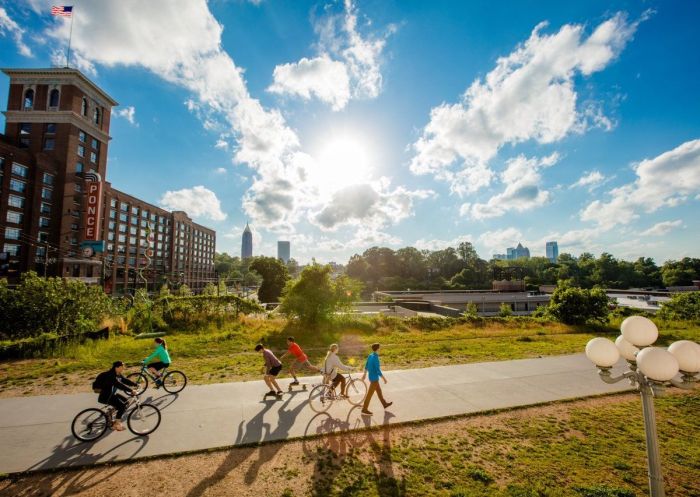
The Atlanta BeltLine has spurred significant real estate development in surrounding neighborhoods, transforming the city’s urban landscape.
Property values along the BeltLine have experienced a surge, with homes near completed segments commanding a premium. The influx of new residents and businesses has driven demand for housing, leading to the construction of new apartments, condos, and townhouses. Developers have also capitalized on the opportunity to create mixed-use developments that combine residential, commercial, and recreational spaces.
Investment Opportunities
The BeltLine has created numerous investment opportunities for developers and homeowners alike. Investors have poured money into acquiring land along the BeltLine, anticipating future appreciation as the project progresses. Homeowners who purchased properties before the BeltLine’s construction have seen substantial increases in their property values.
Challenges and Opportunities
Despite the positive impact on real estate development, the BeltLine has also presented challenges. Rising property values have priced out some long-time residents, raising concerns about gentrification. Developers must balance the need for new housing with preserving the character and affordability of existing neighborhoods.
On the other hand, the BeltLine has created opportunities for homeowners to improve their properties. Many have invested in renovations and additions to capitalize on the increased desirability of their homes. The BeltLine has also spurred the creation of community gardens, parks, and other public spaces, enhancing the quality of life for residents.
Atlanta BeltLine Transportation
The Atlanta BeltLine plays a pivotal role in enhancing transportation options and promoting sustainable mobility within the city. It seamlessly integrates walking, biking, and public transit along its expansive trail network, offering a convenient and eco-friendly alternative to car travel.
By providing dedicated walking and biking paths, the BeltLine encourages active transportation, reducing traffic congestion and improving air quality. The BeltLine also connects with existing and planned public transit lines, such as the Atlanta Streetcar and MARTA, enabling residents and visitors to easily access different parts of the city without relying solely on cars.
Impact on Traffic Congestion
- The BeltLine’s extensive trail network provides alternative transportation routes, reducing the number of vehicles on the road during peak hours.
- By promoting walking and biking, the BeltLine encourages a shift away from car dependence, easing traffic congestion and improving overall mobility.
Promoting Sustainable Transportation
- The BeltLine’s integration of walking, biking, and public transit aligns with the city’s goal of promoting sustainable transportation.
- By reducing car usage, the BeltLine contributes to lower greenhouse gas emissions, improving air quality and promoting a healthier environment.
Last Recap
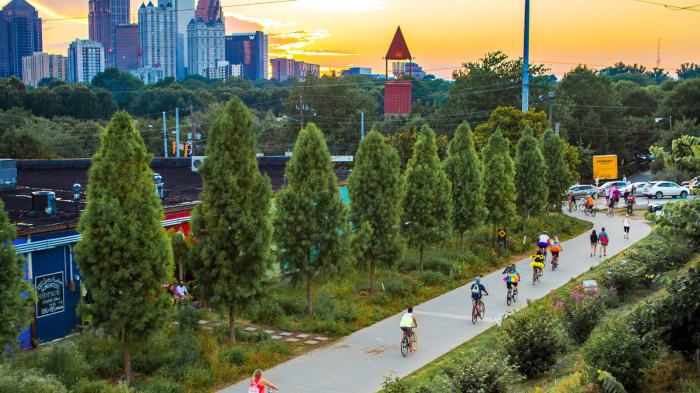
As the Atlanta BeltLine continues to evolve, it promises to remain a catalyst for economic growth, social equity, and environmental sustainability in Atlanta. Its legacy will undoubtedly shape the future of the city, making it a vibrant and livable metropolis for generations to come.
Popular Questions
What is the total length of the Atlanta BeltLine?
The Atlanta BeltLine is a 22-mile multi-use trail system.
How many segments make up the Atlanta BeltLine?
The Atlanta BeltLine is divided into eight distinct segments.
What types of recreational activities are available on the Atlanta BeltLine?
The Atlanta BeltLine offers a wide range of recreational activities, including walking, running, cycling, rollerblading, and more.